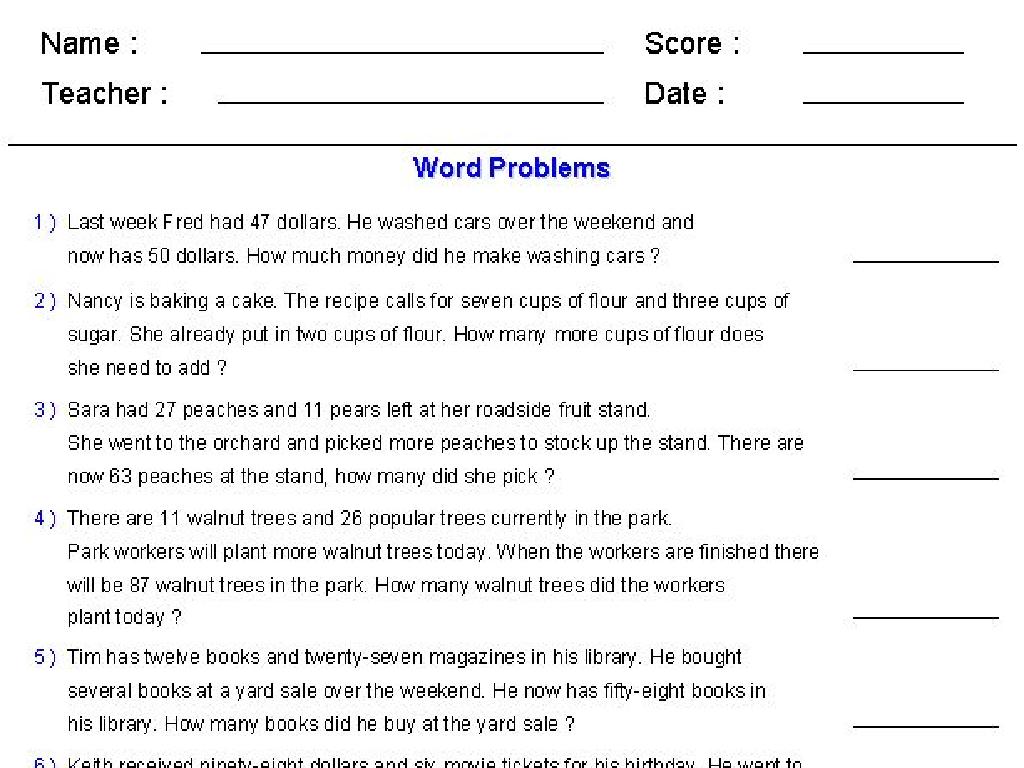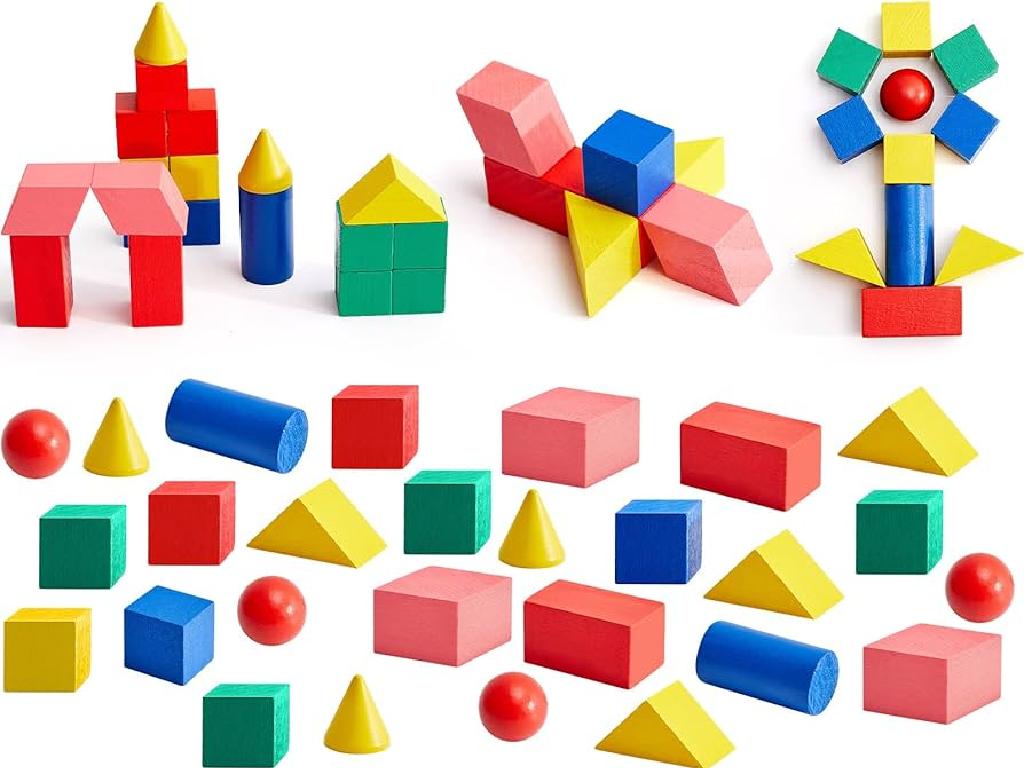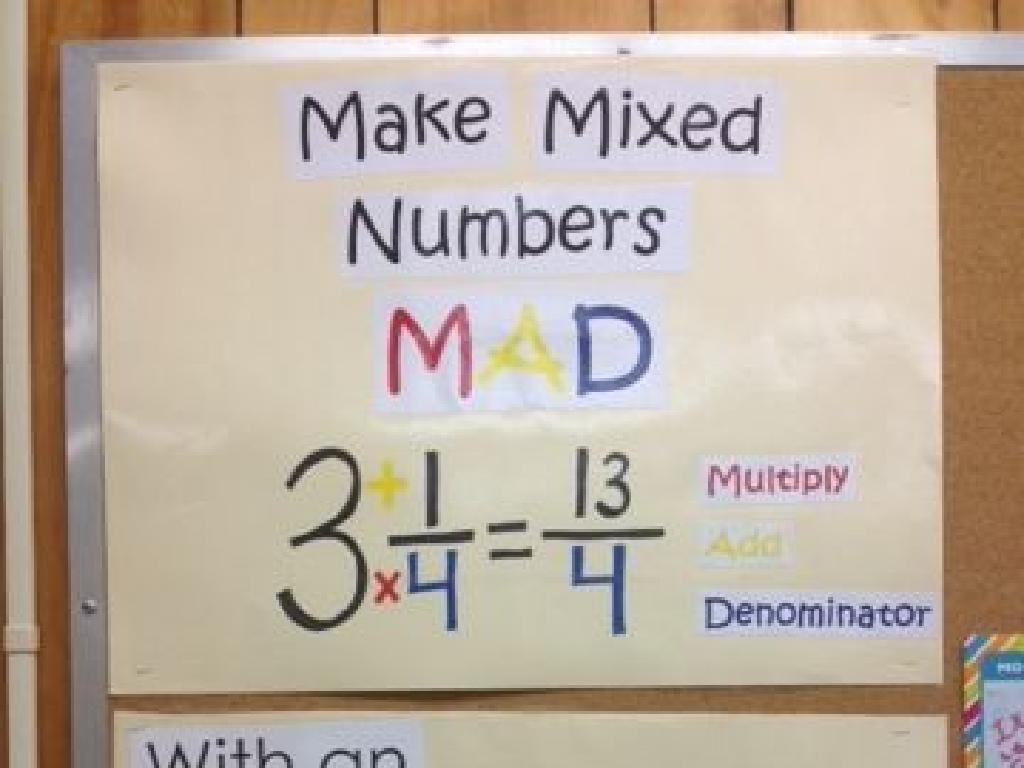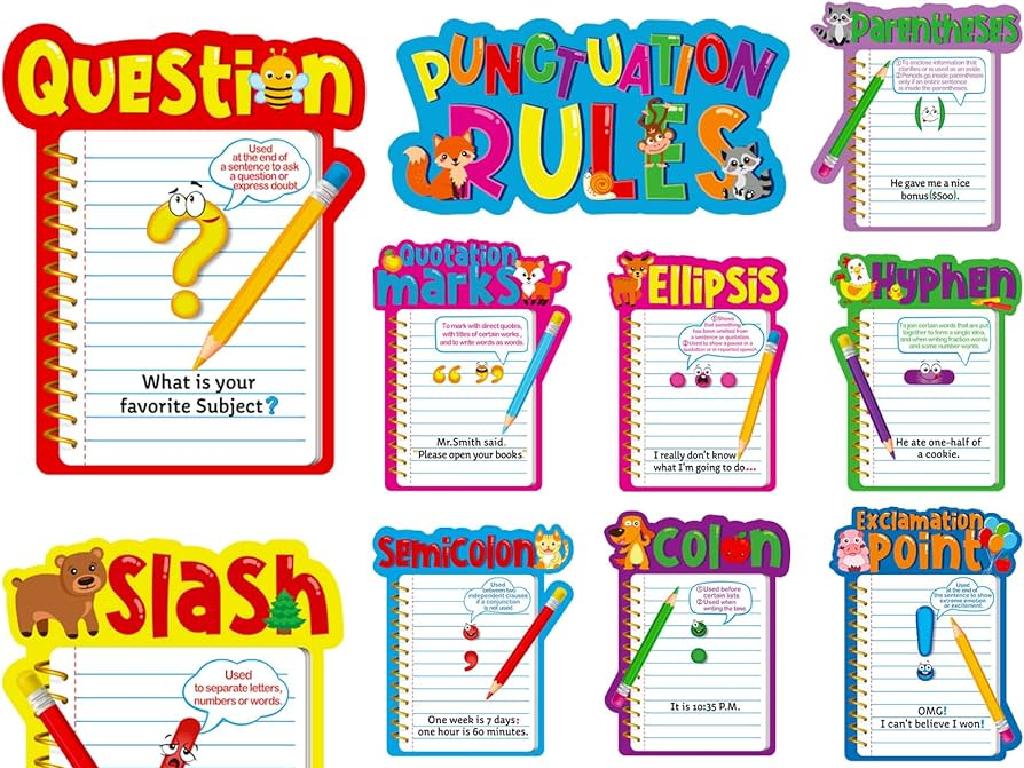Comparing: How Many More?
Subject: Math
Grade: First grade
Topic: Comparing Up To 10
Please LOG IN to download the presentation. Access is available to registered users only.
View More Content
Comparing Numbers: How Many More?
– Learn to compare numbers
– ‘How Many More?’ concept
– Understanding the difference between two numbers
– Compare numbers up to 10
– Using objects like apples or blocks to visualize
– Fun activities to practice
– Games, drawing, and group exercises
|
Today’s math class is focused on teaching first graders how to compare numbers with the concept of ‘How Many More?’. Start by explaining that comparing numbers is like figuring out which of two things is bigger, smaller, or if they are the same. Introduce ‘How Many More?’ as a way to find the difference between two numbers. Use visual aids like counters or drawings to compare groups of items up to 10, which will help them understand the concept in a tangible way. Plan a series of fun and interactive activities where students can practice this skill, such as counting games, matching exercises, or group competitions. This will reinforce their learning and make the concept memorable.
Learning to Compare: How Many More?
– What does ‘comparing’ mean?
– Comparing helps us find if things are the same, less, or more.
– Comparing things in everyday life
– Like comparing apples to oranges, or counting who has more toys.
– Comparing numbers up to 10
– Look at two groups of things, which group has more items?
– Discovering ‘more’ and ‘less’
– Using blocks or fingers to see which is more and which is less.
|
This slide introduces the concept of comparison to first graders by relating it to familiar objects and scenarios. Start by explaining that comparing is a way to see how things are similar or different in quantity. Use tangible examples like toys or fruits to make it relatable. Move on to comparing numbers up to 10, using visual aids like blocks or images. Encourage students to practice by counting items in two groups to determine which has more or less. Reinforce the concept with hands-on activities where students can physically manipulate objects to compare quantities.
Comparing Quantities: How Many More?
– Use objects to compare numbers
– Like blocks or apples to see differences
– Count groups to find ‘more’
– Which pile has more? Let’s count together!
– Introduce the word ‘fewer’
– ‘Fewer’ means not as many. Can we find which has fewer?
– Practice with real examples
|
This slide introduces the concept of comparing quantities using tangible objects, which helps first graders visualize the math concept of ‘more’ and ‘fewer’. Start by explaining that comparing means finding out which group has more or fewer items. Use classroom objects like blocks or apples to create two groups and count each group with the class to determine which has more. Introduce the term ‘fewer’ as the opposite of ‘more’. Encourage students to use these terms in sentences. For practice, have several sets of objects ready for students to compare and use the new vocabulary. This hands-on activity will solidify their understanding of comparison and quantity.
Comparing with Numbers: How Many More?
– Numbers show how many more
– Use a number line to compare
– A number line helps us see the difference between two numbers easily.
– Bigger numbers mean more objects
– Practice with examples
– Example: If Tom has 7 apples and Jerry has 4, how many more apples does Tom have?
|
This slide introduces the concept of comparison using numbers for first graders. It’s important to explain that numbers are not just symbols; they represent quantities. A number line is a useful visual aid that helps students understand the concept of ‘how many more’ by comparing the positions of numbers. Emphasize that the further to the right a number is on the number line, the greater the quantity it represents. Encourage students to practice with real-life examples, such as comparing the number of apples or toys they have with their friends. This will help them grasp the concept of comparison and quantity in a tangible way.
Let’s Practice Comparing Numbers!
– Look at number cards
– Decide which number is more
– Example: 5 and 7
– If we compare 5 and 7, which is bigger?
– Understand 7 is more than 5
– 7 is two steps ahead of 5 on the number line
|
This slide is designed to help first graders practice the concept of comparing numbers up to 10. Start by showing them number cards and asking them to identify which number is larger. Use the example of 5 and 7 to illustrate the concept. Explain that 7 is more than 5 because it comes later on the number line, which means it is greater. Encourage the students to visualize the number line in their minds and to ‘jump’ from one number to the other to see which one is further along. This will help them understand the concept of ‘how many more’ one number is than another. For the activity, have students work with a partner and use number cards to compare and discuss which numbers are more. Provide guidance and support as needed.
Comparing Numbers: How Many More?
– Count to find ‘how many more’
– Compare two groups of items
– If one group has 7 items and another has 5, which has more?
– Use subtraction to find difference
– Subtract the smaller number from the larger: 7 – 5
– Example: 7 items vs 5 items
– 7 is 2 more than 5, so 7 – 5 equals 2
|
This slide introduces the concept of comparing quantities to determine ‘how many more’ one group has than another. It’s important to use hands-on examples with tangible items so that students can physically count the difference. Encourage students to set up their own comparisons using toys, blocks, or drawings, and guide them through the process of subtracting the smaller number from the larger to find the difference. Reinforce the concept by writing out the subtraction equation and explaining that the result shows ‘how many more’ one group has. This foundational math skill will help students with basic arithmetic and understanding of quantities.
Class Activity: The Comparing Game
– Pair up for the Comparing Game
– Compare sets of objects together
– Determine ‘how many more’
– Use objects like blocks or crayons to see which set has more
– Share your findings with the class
|
This interactive class activity is designed to help students understand the concept of comparison by using tangible objects. Students will work in pairs, which encourages teamwork and communication. Provide each pair with different sets of objects such as blocks, crayons, or stickers, ensuring that the quantities are within 10. One student will count one set, and the other student will count the second set. They will then compare to find out ‘how many more’ one set has than the other. Afterward, each pair will have the opportunity to present their findings to the class, reinforcing their understanding and allowing them to practice their counting and comparison skills. Possible variations of the activity could include comparing quantities of shapes, colors, or even items from a story or picture.
Celebrating Comparison Skills!
– Congratulations on learning comparison!
– ‘How many more’ shows difference
– Comparing pencils: If Tom has 7 and Sue has 4, Tom has 3 more.
– Keep practicing comparison
– Use skills in everyday life
– Try comparing toys, books, or snacks at home!
|
Well done to all the students for mastering the concept of comparing numbers up to 10! It’s important to remember that the phrase ‘how many more’ is used to find the difference between two quantities. Encourage the students to continue practicing this skill outside of the classroom by comparing objects they interact with daily, like toys or snacks. This will help solidify their understanding and make them more confident in using comparison in real-life situations. Keep the learning fun and engaging, and remind them that practice is key to becoming great at comparing numbers!






